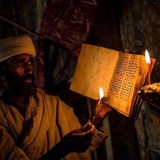tgoop.com/tseomm/6336
Last Update:
Here’s a summary and analysis of the requested text:
Summary
The passage discusses the imagery of Adam and Eve as a parallel to the Virgin Mary's conception and birth of Christ, as interpreted by Jacob of Serugh. The last part of page 160 and the first two paragraphs of page 161 emphasize the idea that Eve was created from Adam’s side without causing corruption to his body. This serves as a typological reference to Christ’s birth from Mary, which also did not alter her virginity.
Jacob of Serugh presents a theological analogy: just as Adam generated Eve without a marital union, Mary, through the Holy Spirit, conceived and gave birth to Jesus without human intercourse. The purity found in Adam is mirrored in Mary, who, by divine intervention, became the mother of Christ without any lustful impulse. Furthermore, Adam's role in generating Eve without union is seen as a foreshadowing of the Virgin Birth, reinforcing the idea of divine purity and spiritual conception.
Analysis
This passage is a theological reflection on virginity and divine intervention in birth, a common theme in early Christian thought. Jacob of Serugh employs typology, a method of biblical interpretation that sees Old Testament events as prefiguring New Testament realities. Here, Adam symbolizes purity before sin, and Eve’s creation without sexual union serves as a precedent for Mary’s virginal conception.
The passage reinforces the notion of divine agency in creation and birth, portraying both Eve’s formation and Christ’s birth as acts of divine will rather than natural reproduction. This argument upholds the doctrine of Mary’s perpetual virginity and aligns with the broader Christian tradition that views Christ’s birth as a miraculous fulfillment of divine prophecy.
Would you like a more in-depth theological analysis?
አዎ አልኳት
In-Depth Theological Analysis
Jacob of Serugh, a 5th-6th century Syriac poet-theologian, uses typology to connect the Old Testament creation narrative with the New Testament doctrine of the Virgin Birth. His interpretation is deeply rooted in patristic theology, where Adam and Eve serve as foreshadows of Christ and Mary. This method aligns with early Christian exegesis, particularly in the Syriac tradition, which often drew analogies between Genesis and Christ’s redemptive work.
1. Adam as a Type of Christ, Eve as a Type of Mary
Jacob presents Adam as a prefiguration of Christ and Eve as a parallel to Mary. The creation of Eve from Adam’s side without marital union is seen as a precursor to Christ’s birth from Mary without human intercourse. This typological reading suggests that just as Eve was formed without the corruption of natural generation, so too was Christ born without disrupting Mary’s virginity. This reinforces the theological claim that Christ’s birth was unique—both fully divine and fully human—while preserving Mary’s purity.
2. The Role of the Holy Spirit in Birth and Creation
The passage emphasizes the role of the Holy Spirit in both the creation of Eve and the conception of Christ. Jacob describes how the Holy Spirit "blew on Adam’s face and generated Eve," mirroring how Mary "received and gave birth to a Son" by the power of the Spirit. This poetic parallel strengthens the idea that divine breath (ruach, meaning "spirit" in Hebrew) is the creative force behind both events. By linking these two moments, Jacob highlights the continuity between the Old and New Covenants, showing that divine intervention operates beyond natural reproductive processes.
3. Virginity and the Absence of Lust
BY ኦርቶዶክሳዊ መጻሕፍት እና ጽሑፎች Tsegaye kiflu
Share with your friend now:
tgoop.com/tseomm/6336
